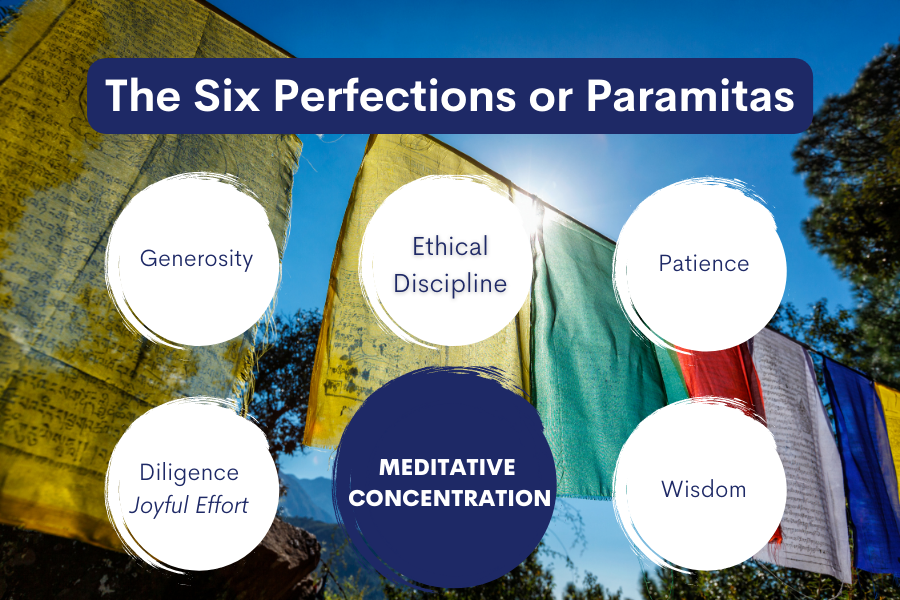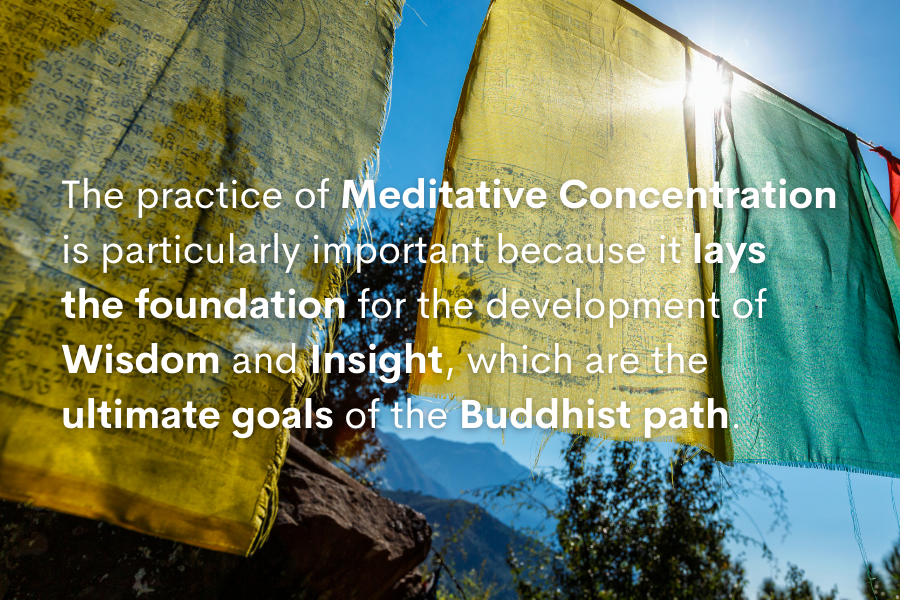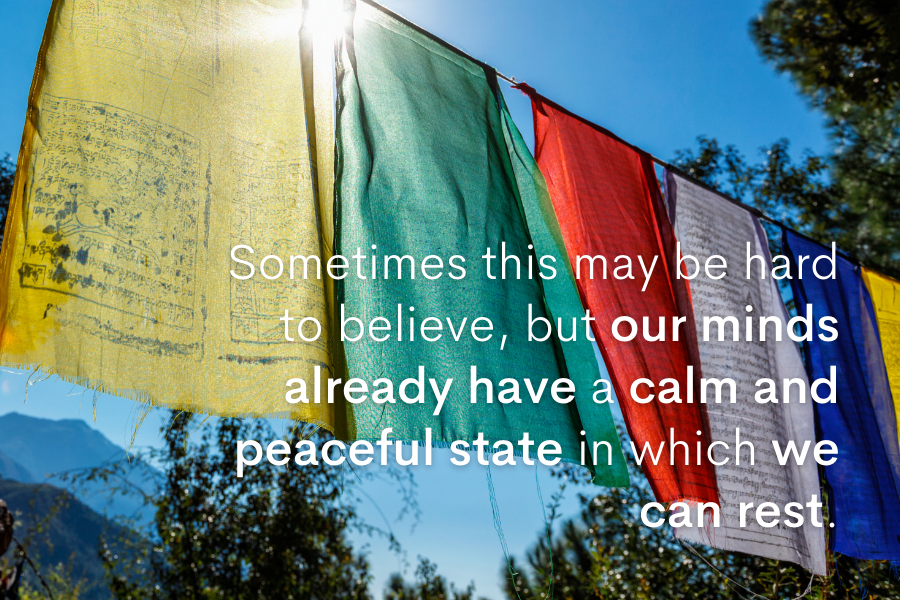The Six Perfections are Generosity, Ethical Discipline, Patience, Joyful Effort (a.k.a. Diligence), Meditative Concentration, and Wisdom. Each of the Six Perfections is considered essential for achieving enlightenment.
The practice of Meditative Concentration is particularly important because it lays the foundation for the development of Wisdom and Insight, which are the ultimate goals of the Buddhist path.


What is Meditative Concentration?
Meditative Concentration means for one’s mind to rest on a single, virtuous object, such as the breath or a visual image, in order to cultivate a sense of calmness and inner peace. “Virtuous object” here means an object that doesn’t give rise to non-virtuous thoughts and emotions. As you can imagine, it would be hard to develop Insight and Wisdom without being able to settle your mind on anything. Likewise, it would be hard to reach enlightenment without Insight and Wisdom.
So a good place to start that progression is by practicing Meditative Concentration.
How can I practice Meditative Concentration?
We cultivate this power of focus and attention through practicing Shamata or Calm Abiding. Of course, to improve at something, we need to do it a whole lot. In this type of meditation, we focus on an object again and again, attempting to sustain single-pointed focus for as long as possible. As we gain experience in this type of practice, we will move from focusing on an external object to focusing on an internal object. Learn more about the progression of Shamata HERE.
The practice of Meditative Concentration involves training your mind to remain focused on a single object without distraction. Realistically, this looks like refocusing the mind over and over again, as the mind is prone to wander and become distracted by our settings and our own thoughts and feelings. I often think of it as “forgetting and remembering; forgetting and remembering.” That cycle actually strengthens specific parts of our brains that really help us focus—which is useful for many things—but also in having that extra moment in challenging moments, in real-time, so that rather than the instinctive knee-jerk reaction, we can come from a more skillful, heartful place.
Similar to any type of physical training, we should begin with short periods of practice. If we wanted to be able to do the splits, we wouldn’t pop down into the splits on day one, would we? No way! (Please don’t attempt that!) We begin with short periods of practice, gradually increasing the length of each session over time.
Ideally, we meditate in peaceful environments free from distractions and interruptions. Realistically, we can’t expect this for every practice session. So, we can think of the noises around us as opportunities for improving our ability to focus. Perhaps you can add a few personal items to your meditation space so that when you are in the space, you feel at ease.
Here’s more on cultivating Meditative Concentration from Lama Tsomo’s most recent book, Deepening Wisdom, Deepening Connection,
“Clearly, we can’t get anywhere using any of the mind-training methods without this one either; yet we start the path with precious little of it. We’ve talked about this catch-22, and again, the answer is gentle perseverance—Joyful Effort, not to mention forbearance!
“Now we have brain studies to show that we can make huge changes in our brains over time, like water on stones. What surprised me about those studies was that measurable change started within weeks. If we cultivate concentration more and more as our capacity grows, then we can make progress with all of our other goals.
“It’s fairly obvious that if we want to concentrate well, we have to eliminate (or at least firmly minimize) distractions. On the face of it, a distraction could mean answering the phone while meditating or having a TV going in your meditation area. Less obvious are the distractions of your life. As you’re pursuing the things and people you want and trying to eliminate those you don’t want, you’re providing another level of distraction. These fixations are at least as threatening to your concentration as the phone or TV. Notice the inner conversations and strategizing that continually push their way into your meditations.
“The more we realize the futility of hoping that the things of Samsara will bring us real, lasting happiness, the more we naturally turn away from those things—let go of them.
“Once again, we need to let go of all hope and fear as much as we can. That, in turn, allows us to pursue this path with less distraction. The resulting progress allows us to feel real satisfaction and happiness more and more. Again, the upward spiral of this path.”
Excerpt from: From Ancient Wisdom for Our Times: Tibetan Buddhist Practice: Deepening Wisdom, Deepening Connection, Namchak Publishing Company LLC, p 96.
The Benefits of Meditative Concentration
Sometimes this may be hard to believe, but our minds already have a calm and peaceful state in which we can rest. Through Meditative Concentration, we cultivate an ability to stay in that place for longer and longer periods of time: a mini vacation, if you will. Maybe even more restful than sitting on the beach with our heads buzzing with thoughts!
Developing this single-pointed focus involves paying attention to the present moment without judgment or attachment to thoughts or emotions.

What if you had an extra moment before the knee-jerk reaction set in, and your words or tone of voice didn’t blurt out something unskillful? What if, instead, there were a bridge to the higher parts of your brain, where you could formulate a more kind and skillful response? Brain science points to exactly this capacity that increases with Shamata practice!
Meditative Concentration is essential for developing the other five perfections, as well as for achieving enlightenment.
By cultivating a calm and peaceful mind, we are able to develop greater compassion, wisdom, and insight. In the big picture, this moves us along on the Path. At the same time, this capacity of Meditative Concentration can improve our interactions, relationships, and ultimately, the quality of our lives. And we can more fully enjoy sitting on the beach.
After all, we want to be awake to and aware of all our experiences, right?
To start or rejuvenate your Shamata practice, join Khen Rinpoche in this eCourse. Or try various types of Shamata from our Guided Meditation Library.
